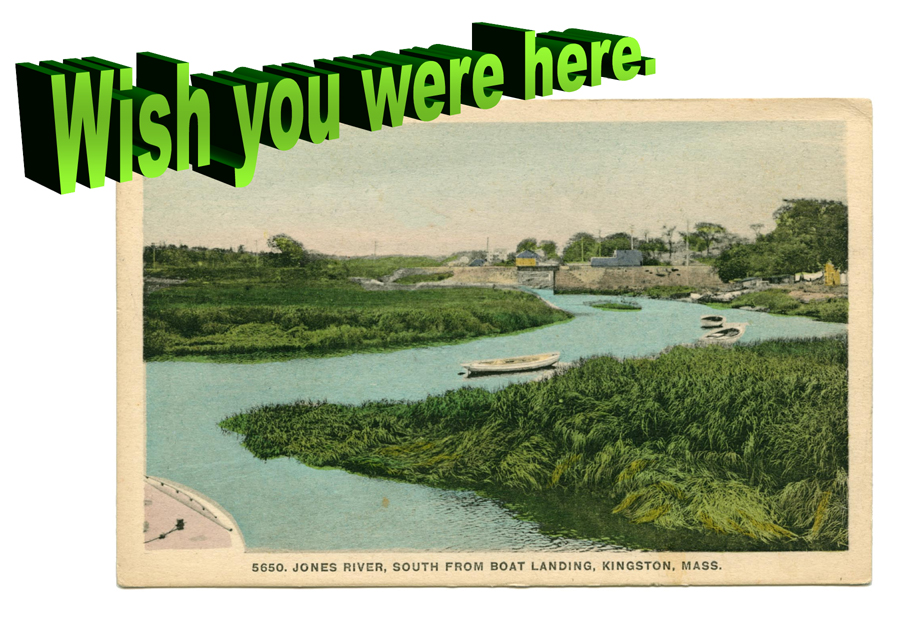
The exhibit for April in the Local History display case is a selection of early 20th century color postcards showing Kingston buildings and places.
Stop by and take a look!
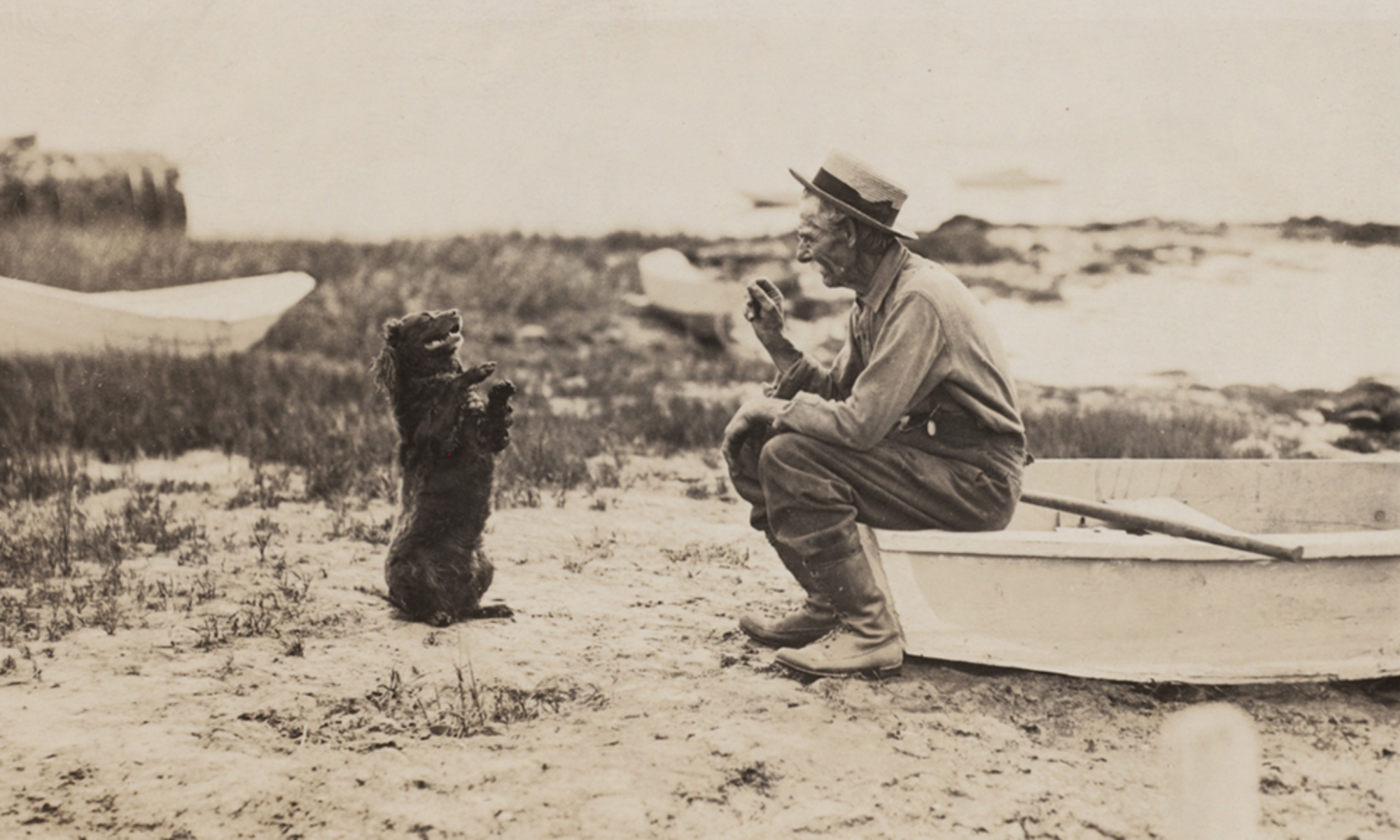
Kingston (Massachusetts) Public Library
Here are two views of a trolley accident in Kingston from sometime in 1910.
The cars shown here belonged to the Plymouth & Brockton Street Railway Company, which was originally called the Plymouth & Kingston Street Railway. For more information on the company, which still runs buses in the region, visit the history page of their website.
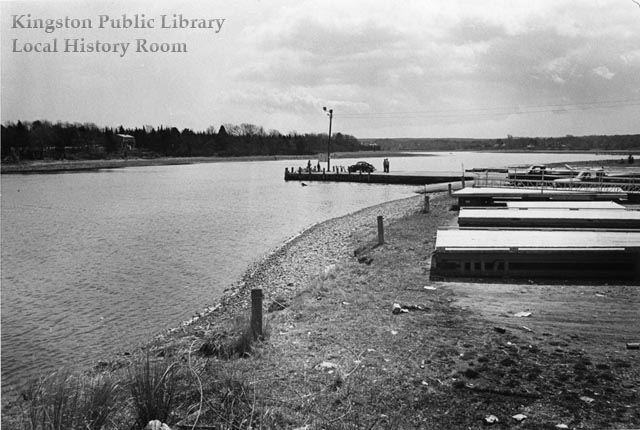
Lying at the foot of River Street, the Town Landing provides access for boaters to the Jones River, as well as a lovely place to sit and watch the water flow into Kingston Bay. These two photos were taken by Ted Avery in April 1975.
Forty years earlier, this was the site of one of Kingston’s Emergency Relief Administration (E.R.A.) projects. Between April and August 1935,
The old wharf was raised 18″ and extended 25′ out into the Jones River, 90 cu. yds. of stone was laid and pointed, 28 piles were set and held in place with iron straps, a cement cap 18″ wide 1′ thick reinforced with iron rails using 40 bags of cement was put on top of the extention [sic], 105 cu. yds. of stone was used, 300 cu. yds. of gravel for filling, also 100 cu. yds. of mud was excavated from river and used for filling.
Edgar W. Loring donated the stone, while Dr. Arthur B. Holmes contributed the pilings. When complete, the entire project cost $3191.04. Asked in the final engineering report how the public benefited from the project, George P. Holmes, the Town’s E.R.A. Administrator, replied “This wharf at present is the only public landing place for fishermen and yachtsmen in Kingston and the extension to low water mark is greatly appreciated by same.”
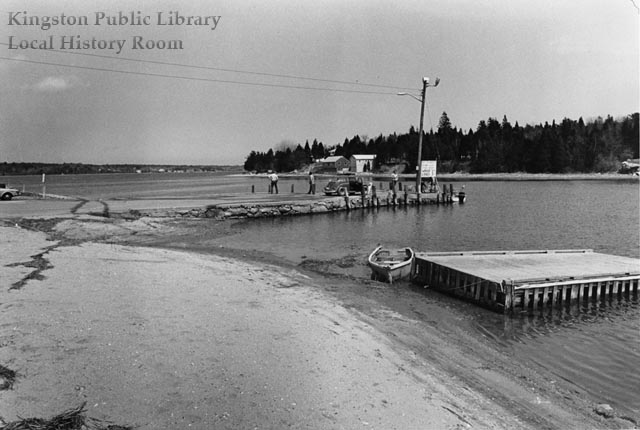
More recently, in 1997 the Massachusetts Office of Coastal Zone Management gave $32,000 in Seaport Bond funds to the town, allowing the Waterfront Committee to replace older wooden floating docks (visible in both photos) with 20 modular aluminum versions. In 1999, Chris Tura completed his Eagle Scout project by dedicating the “Independence Memorial Park” at the Town Landing, complete with a historical marker, granite curbing and refinished picnic tables and benches.
Sources: Town House Attic II papers; Town Annual Reports; Vertical File: Independence Park.
Emily Fuller Drew took this photograph “expressly for the booklet” The Story of Jones River, which she and Sara Y. Bailey completed in 1920. The original caption reads “Flat House Dock. The home of Joseph Bradford, youngest son of the Governor. It is said that the name was given because of the flat roof of Mr. Bradford’s warehouse at the wharf.”
The area, known as the “Short Reach,” was also the site of a lumber yard, probably supplying timber for ship builders. Facing north, Emily shot this image standing near the spot where today Route 3 crosses the Old Colony Railroad tracks, seen in the foreground. In the background left, Captain Joyce’s stone house at 5 River Street is visible, with the Bay Farm at right in the far distance. The Jones River takes a reverse S-curve here.
It is one of my favorite landscapes.
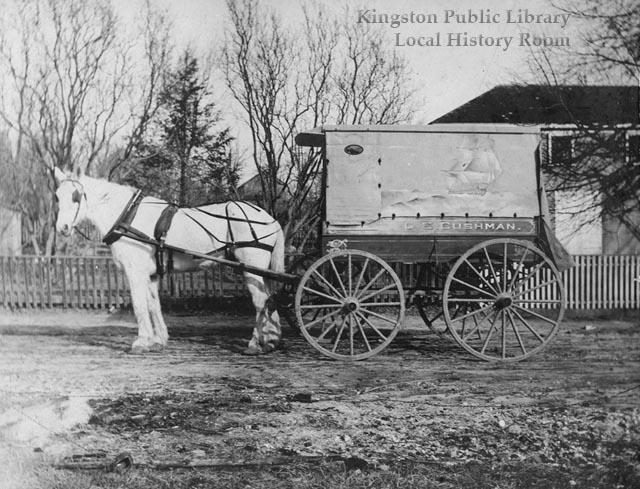
Even before the days of online ordering and overnight shipping, groceries and other necessities could appear at your door on demand, delivered perhaps by the horse-drawn wagons of Kingston merchant George E. Cushman. From 1864 when he began clerking in Azel Sampson’s dry goods store at 196 Main Street to 1919 when he retired from his own establishment across the street at 193 Main, Cushman sold groceries, flour, grain, candy, yard goods, drugs, boots and shoes. During much of that time, the store also housed the post office, with Cushman served as the assistant postmaster.
The wagon above sports a proud sailing vessel, homage to Kingston’s shipbuilding heritage, while the one below displays a peaceful rural road, testament to the town’s bucolic character. As one of a number of competing retailers in town, Cushman may have added a competitive edge with these elegantly decorated wagons.
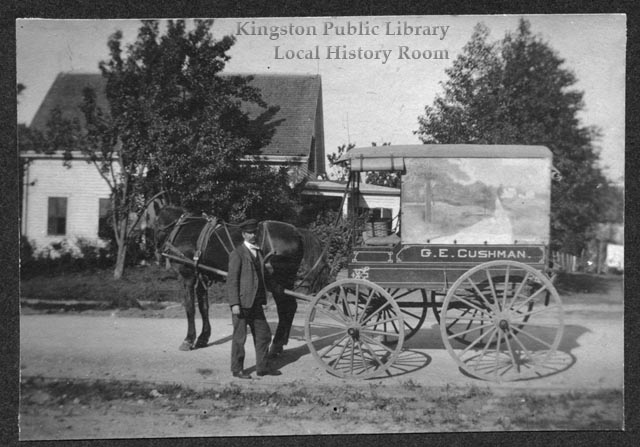
Sources: Photos from the Margaret Warnsman Collection; other information from House Histories, Vertical File: Businesses, and the Eleanor Loring Cole Collection.
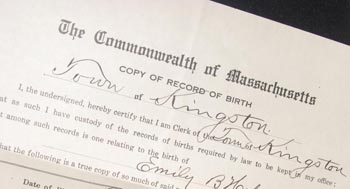
Vital records are the most basic paperwork of human life, the tangible evidence of the three most important events: birth, death and marriage. In Massachusetts, these events have been registered at the local level since 1635 and formally collected by the state since 1841. On display this month are a few examples of the forms that vital records take. Stop by and take a look.
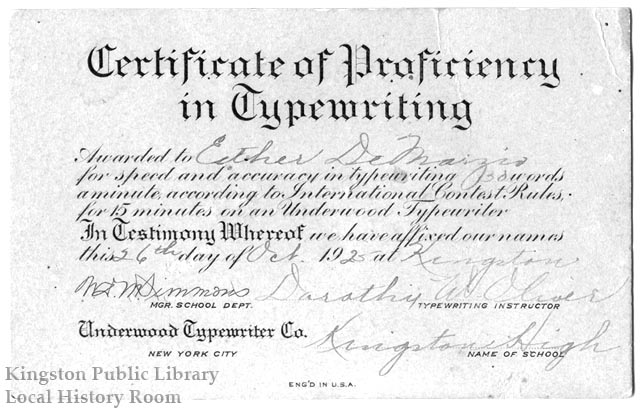
Here is a recent acquisition, a fragment of the past that made its way into the Local History Room. This wallet-sized certificate attests to the speed and accuracy of the typwriting skills of one Esther De Marzio. Who was she, we ask?
A 1927 Kingston High School graduate, Literary Editor and writer for The Quill, the KHS literary magazine, a teacher at Kingston Elementary School for 38 years and Principal there for 34, Miss De Marzio (or Di Marzio, as sometimes appears) moved to Kingston at the age of 10 and spent the next 80 years here. She volunteered in the Local History Room, served on the scholarship committee of the Council on Aging, read for the blind, traveled the world and enjoyed Gray’s Beach and her garden. Here she is sometime in the 1930s.
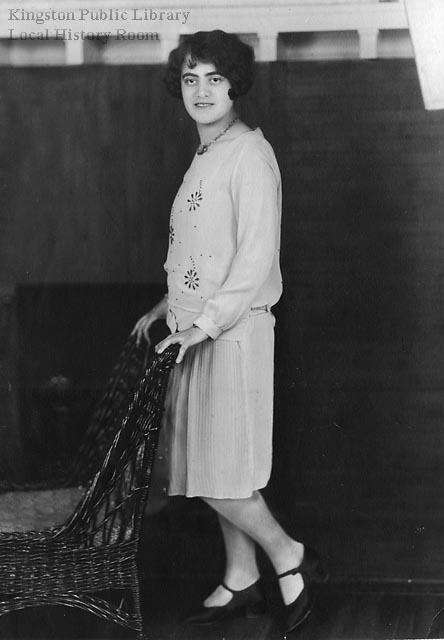
To find out more on Underwood typewriters (don’t laugh: the history of office equipment is fascinating!), click here or here.
Source: Kingston Reporter, “Florence DeMarzio, 90, school principal,” August, 17, 2000.
The Local History Exhibit for February starts with the game of Kingstonopoly, a customized version of the classic board game Monopoly done for the PTO of Kingston Elementary School in 2000. Looking through the collections of the Local History Room, we find not only a pair of adorable wooden boxes fashioned after houses out on Wapping Road (buy a house), but letterhead from the Kingston Inn (build a hotel), stock certificates (collect $200), promissory notes (borrow from the banker), and foreclosure documents (don’t go bankrupt). Life imitates the game and our historical collections represent a slice of life.
Stop in and take a look!
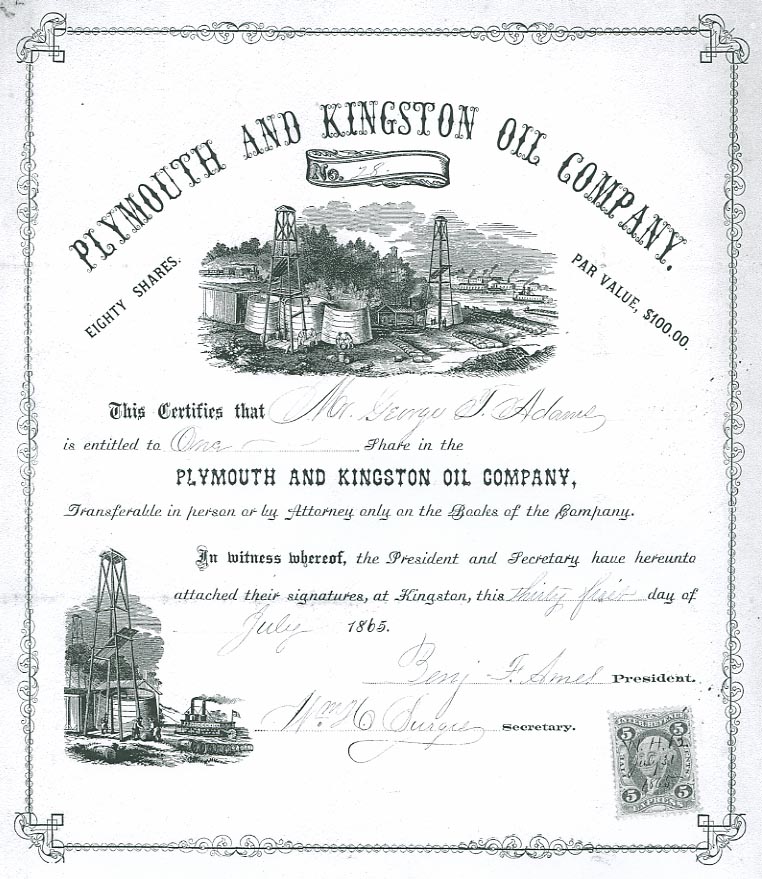
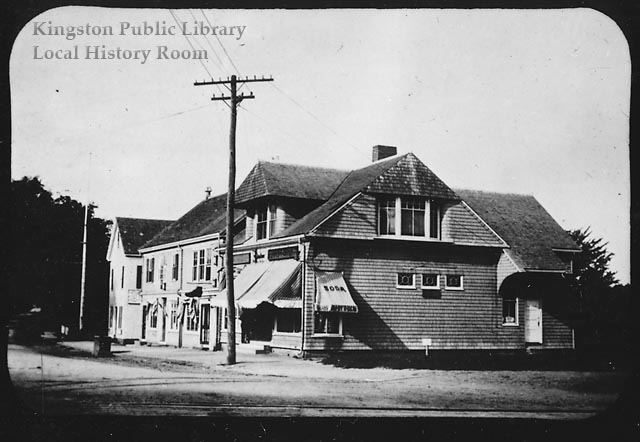
The original Adams Block consisted of avariety of buildings picked up here and there by Horatio Adams, moved onto Summer Street and joined together in a new kind of retail conglomeration. A novel idea in the 1840s, the business block was a bold experiment. The nature of the structure, however, made it a fire trap and when fire did come, considerable damage resulted.
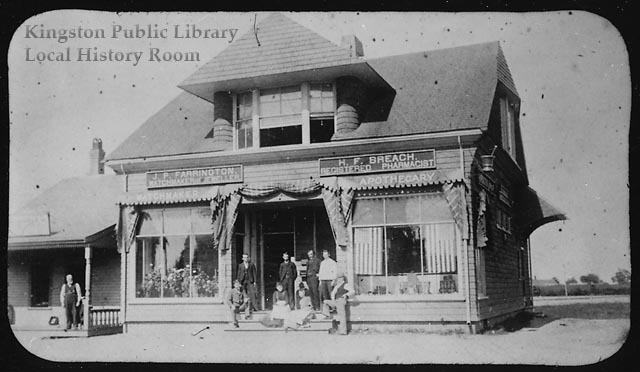
The main building shown here sat on the east side of Summer Street on the Stony Brook side of the railroad tracks. In the early part of the 20th century, the apothecary of H.F. Breach, Registered Pharmacist and J.P. Farrington, Watchmaker & “Jeweller” occupied the ground floor of what had previously been Samuel E. Cushman’s barn, previously located on the site of the railroad station (now Solstice restaurant). On the upper floor, Mr. Adams provided rooms for a number of small businesses including dentist Dr. George Baker and ladies tailor George Bradley. In later years, Miss Annie M. Marsh set up her dressmaking concern and Dr. Carl Stegmaier took over the dental office upstairs. Another building (formerly a blacksmith shop) housed the fish market with bins that drained directly into the Stony Brook which ran below the building. Later raised to two stories, this structure housed lawyer John T. Smith’s shoe store.
Harry West’s harness shop and a series of grocery and meat concerns later absorbed by Steele & Farrington, occupied additional buildings in the Adams Block. Upper rooms were rented to the Men’s Social Club and the Arrananuchs Club for boys. Beyond was the G.A.R. Hall, later Esther’s Restaurant and today a hair salon.
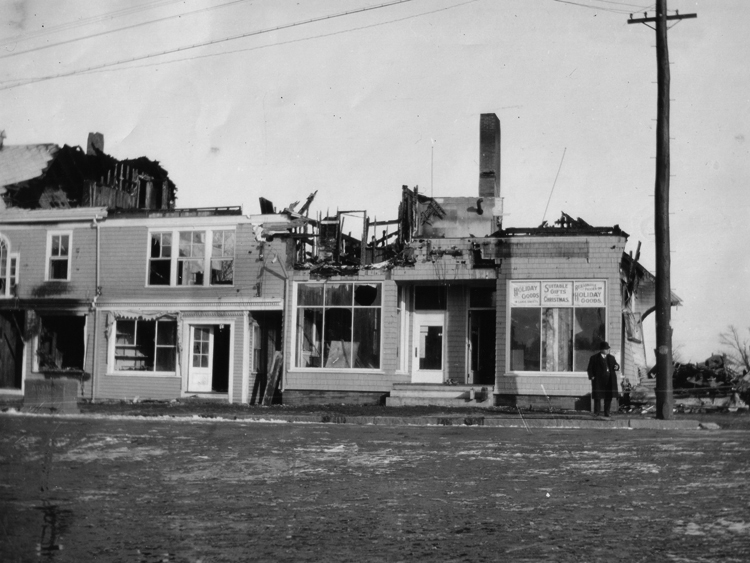
On the night of December 28, 1911, fire wrecked most of the buildings except the north end. The damaged stores were rebuilt into one continuous single-story building, still standing today. Despite the devastation, Mr. Adam’s experiment certainly proved a success as the “Block” has been the center of Kingston business through god times and bad for more than a century and a half.
Sources: Lantern slide card file, Emily Fuller Drew; Major Bradford’s Town, Doris Johnson Melville (Town of Kingston, 1976).